A reported robbery of priceless jewelry at the Louvre has set off urgent questions about museum security. The incident in Paris, detailed by security specialists, could drive a wave of policy reviews across major institutions. The focus is on how museums protect rare objects while keeping galleries open to the public.
“The Louvre Museum robbery of priceless jewelry may prompt museums worldwide to review their security programs and protocols,” according to experts.
Officials have not detailed the full timeline or the tools used by the thieves. But security professionals say even small gaps can lead to large losses. The pressure to act is rising as cultural sites navigate tight budgets, crowded venues, and evolving threats.
Why this matters now
High-profile thefts can trigger copycats and strain public trust. They can also force museums to answer tough questions about staffing, technology, and training. The stakes are more than financial. Once a unique piece is lost or damaged, the cultural loss is permanent.
Museums also face scrutiny from insurers. Premiums, deductibles, and policy terms often change after major incidents. That can ripple through loan agreements and exhibitions. A single breach can affect programming and revenue for years.
A pattern of high-stakes thefts
Art and jewelry theft is not new. The Isabella Stewart Gardner Museum heist in 1990 remains unsolved and reshaped museum risk planning in the United States. In 2019, thieves took royal jewels from the Green Vault in Dresden, prompting upgrades across Europe. These cases show how quickly skilled criminals can exploit security blind spots.
Experts say criminals study guard routines, display cases, and emergency procedures. They also test response times. Social media can add risk by publicizing floor plans or showing valuable items on temporary display.
Where security breaks down
Specialists point to a mix of human and technical factors. Night shifts are thinly staffed. Alarms are not always integrated. Old display cases can lag behind current standards. In busy galleries, crowding makes it hard to spot unusual behavior.
- Gaps between camera coverage zones
- Delayed alarm verification and response
- Infrequent stress tests and after-hours drills
- Inconsistent key or access control for contractors
- Limited analytics for unusual movement or heat signatures
There is also a rising risk of insiders or contractors abusing access. Background checks vary by institution. So do procedures for tracking who handled cases, mounts, or locks.
What museums may change next
Security advisers expect a swift round of internal audits. Many will recheck display cases for tamper resistance, reviewing glass ratings, hinges, and alarm contacts. Expect more unannounced drills and scenario planning with local law enforcement.
Institutions may add layered monitoring: upgraded cameras, better lighting, and analytics that flag loitering or rapid crowd movement near high-value cases. Some will revisit guard deployment to reduce predictable patrols. Others may rotate marquee items to reduce exposure and keep thieves guessing.
Insurance partners will likely press for documented improvements. That could include clearer chain-of-custody logs for keys and tools, and tighter controls on after-hours work. Training will be a focus, with scripts for fast lockdowns and evacuation routes that do not help a thief escape.
Balancing access with protection
Public access is central to a museum’s mission. Heavy-handed measures can turn visitors away. Leaders face a hard choice: increase barriers or risk more losses. Some institutions will lean on invisible measures—smarter sensors, discreet guards, and quick-response teams.
Visitors may notice modest changes. Bags could be screened more often. Certain rooms might have timed entry. Labels may move off cases to reduce crowding. These steps seek to cut risk without harming the visitor experience.
What to watch
Security chiefs say the next few months are key. If museums show clear upgrades, they can reassure lenders, donors, and the public. If not, loan programs and special exhibitions could tighten, limiting what audiences can see.
The broader lesson is simple. High-value objects need layered protection backed by trained people and real drills. As one consultant put it after the Paris incident, the question is not whether a museum can stop every attempt. It is whether it can detect fast and respond faster.
The Louvre episode has become a stress test for the sector. Many institutions will treat it as a cue to fix weak links now. The art remains priceless; the time to strengthen defenses is short.







